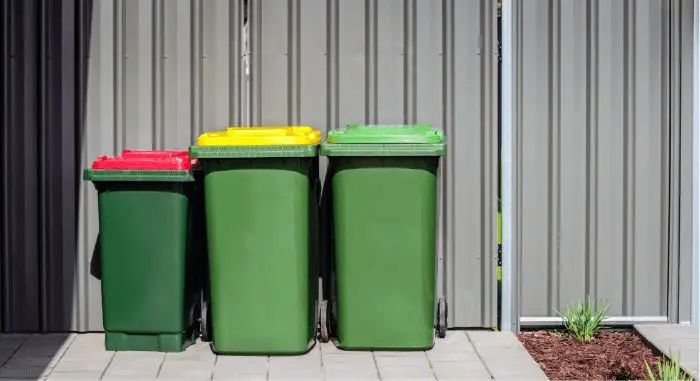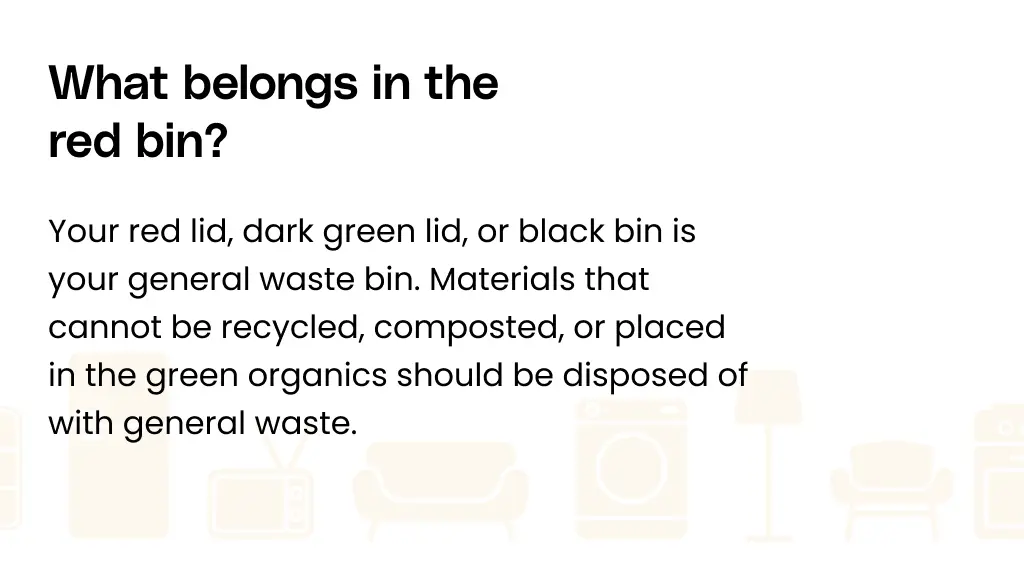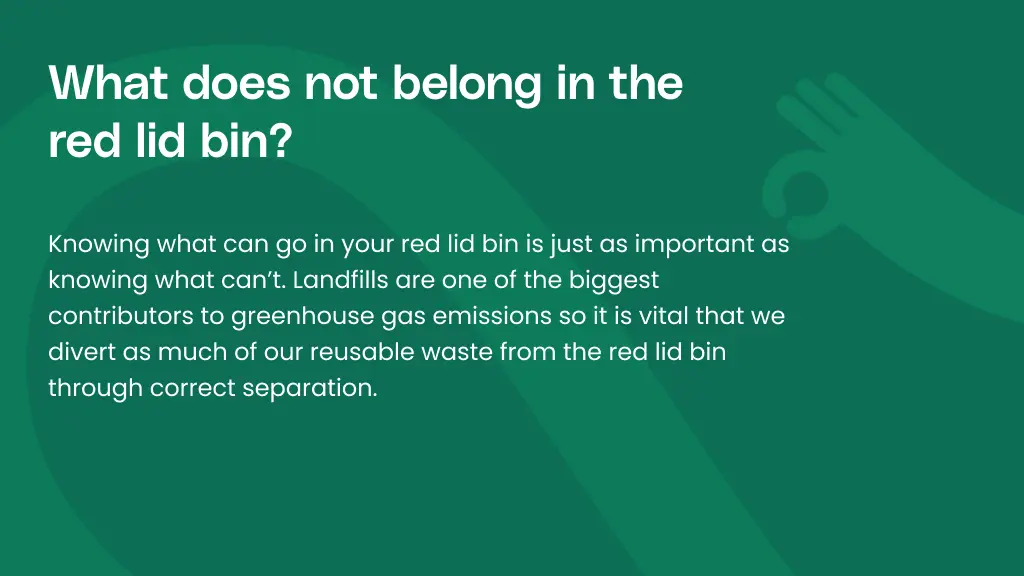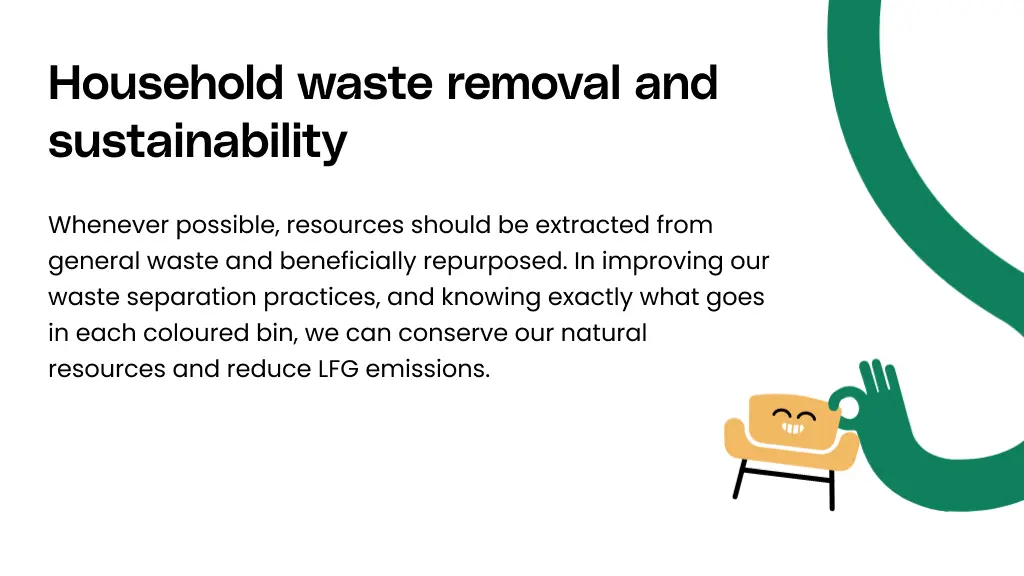
We often consider the red bin to be our comprehensive, one-stop spot for waste removal. While it should contain our general household rubbish, not anything and everything can be discarded in the red lid bin.
It has never been so important to differentiate household waste from your recyclables and organics. Half of the generated waste in Australia has the potential to be converted into compost and returned to the earth; however, unfortunately, this is not the case for how waste is generally disposed of in Australia and NSW. Understanding how to separate your rubbish properly is the key to long-term, sustainable waste removal and reducing greenhouse and landfill gas emissions.
Within this article, we'll break down the questions you may have surrounding household waste disposal in Sydney, so that by the end, you know exactly what goes in the red bin!
What Goes in the Red Bin?
Depending on where you’re located, your red lid, dark green lid or black bin is your general waste bin. Materials that cannot be recycled, composted or placed with the green organics should be disposed of with general waste.

Items that should go in the red bin include:
- Plastics and plastic containers
- Soft plastics such as food packaging and wrapping
- Polystyrene (food trays and foam packaging)
- Styrofoam (food packages and take-away coffee cups)
- Bones and Meat products
- Used paper, tissues, and paper towels
- Disposable coffee cups
- Nappies and sanitary items (including biodegradable and compostable)
- Broken toys
- DVD’s, CD’s, videos and cassette tapes
- Pool and garden hoses
- Old clothing (but always try to donate them if they are in good condition)
The line between what can and can’t be recycled is often blurred. When considering what goes in the recycling and what goes in the red lid bin, one of the first things to think about is contamination.
To avoid recycling contamination, when the item has food or grease residue, it should be thrown in the red lid bin. Items that are relatively clean and are not single-use, can be safely recycled. We must separate our contaminated household waste, from our recyclables to avoid recycling contamination and divert any reusable items from landfills.
Contaminated recyclables may include bathroom products that have been used, such as old toothbrushes and empty toothpaste tubes. Used paper products including hygiene and sanitary products, used tissues, paper napkins, and paper towels should not be recycled and should go into general waste.
Single-use paper products have often already been recycled. The fibres are too short and so, even if they are clean, they should be placed in the red lid bin with the general waste.
Receipts printed on thermal paper contain BPA, which cannot break down or be recycled and must go in the red bin.
What Does Not Belong in the Red Lid Bin?
Knowing what goes in the red bin is just as important as knowing what can’t. Landfills are one of the biggest contributors to greenhouse gas emissions so it is vital that we divert as much of our reusable waste from the red lid bin through correct separation.

Do not place these recyclable items in your red bin:
- Plastic bottles
- Glass bottles and jars
- Metal containers, including tin, aluminum, and steel cans
- Papers and cardboards
Please note that recyclable items should be relatively clean, and free of food and grease residue. If they are contaminated, they should go with your general waste.
Plastics are some of the most common rubbish items generated by our households. A variety of goods are packaged in plastic wrappings, such as food, apparel, household items, and electronics. While this can be disposed of with general rubbish items, it oftentimes can be recycled. Ensure to empty your plastic containers and give food packaging a good rinse before recycling. If there are remnants of food, choose to dispose of them in the red lid bin.
Other items you do not place in your red bin:
- Building waste
- Garden and green waste
- Whitegoods
- E-goods such as software and other electronic waste
- Mobile Phones
- Batteries
- Print ink and toner cartridges
- Paint
- Medical waste
- Hazardous materials
- Car parts and tyres
- Household chemicals
- Needles, sharps, and syringes
These items can often be recycled and repurposed to divert landfill. Hazardous materials however are not safe for curb side collection as they could pose dangers and health risks.
What About Garden Organics?
So, can you put garden waste in the red bin? No, primarily for environmental reasons.
Your garden waste is biodegradable and should not be discarded in the red lid bin with your non-organics. Organic materials that end up in landfills are major contributors to greenhouse gas emissions.
Organic waste may include:
- Grass clippings
- Leaves
- Shrubs
- Small twigs and branches
- Weeds
- Plants and flowers
- Other pruning materials
The correct removal of your garden organics from your general rubbish is crucial to minimising the environmental impact of landfills. Green waste is sent to a recovery facility where it can be treated, decontaminated, and converted into compost, soil conditioners, fertilisers, and mulch products. Ensuring you don’t contaminate your garden organics with items that belong in your general waste, is also advantageous for collectors who screen and decontaminate garden organics in an effort to reduce landfill.
Household Waste Removal and Sustainability
Landfills are not sustainable for long-term waste removal. If we believe that everything can go in the red lid bin and that a few garden organics and recyclables in the red bin each week won't do any harm, we are mistaken. We worsen our ecological footprint and this can have detrimental impacts on our environment.
Proper waste disposal is a crucial component in reducing greenhouse gas emissions. Landfill gas (LFG) is a by-product of the decomposition process that occurs when organic materials are buried in Landfills. LFG is comprised of 50% methane, and 50% carbon dioxide. Methane is a major contributor to global warming and is one of the largest sources of human-related methane emissions. As a potent greenhouse gas, it is effective at trapping heat in the world’s atmosphere. To put it in comparison, Methane can retain more than 25 times more heat than carbon dioxide.
This is why it is crucial to carefully consider what goes in the red bin, and properly separate our organics, and our recyclable goods from our household, general waste.
Whenever possible, resources should be extracted from general waste and beneficially repurposed. In improving our waste separation practices, and knowing exactly what goes in each coloured bin, we can conserve our natural resources and reduce LFG emissions.

Where Does Red Bin Rubbish Go?
With most households filling up one or two red lid wheely bins per week, you might wonder, “where does all the red bin rubbish go?”.
General waste items that are single-use, contaminated, and unable to be re-used will be processed in Landfills. There are three main landfill sites in Sydney for non-organic and un-recyclable red bin rubbish.
When your general rubbish arrives at a landfill site, it will be filtered through a waste treatment facility where any recyclables will be sorted and separated from the un-reusable goods. Any items that cannot be repurposed are buried in the earth. This will cause them to inevitably emit landfill gas and methane over time. To this effect, we can understand why it is so important to grasp the contents of general rubbish wheely bins and know exactly what goes in the red bin.
Some General Waste Disposal Tips
Ensure you don’t overload your red bin, and make sure the lid can be closed. A general rule of thumb is to put your bin out for collection at 80% capacity with all contents contained inside. This prevents overloaded items from getting wedged and stuck, making disposal difficult for the collector. Use bin liners to prevent spillage when your bin is picked up for collection.
In the hotter months, the odours from your red lid bin can get eye-watering. Keep your wheely bins in the shade and for nappies and sanitary items, try deodorised biodegradable nappy bags.
If the stench ever gets too potent, clean your red bin out with a high-pressure hose and disinfect it. You can use laundry detergent, a strong disinfectant, and boiling water to loosen any residue that may be clinging to the walls of your bin.
If you ever encounter maggots and fly eggs, pour boiling water over them to kill them.
When Does the Red Bin Get Collected?
Sustainability is at the forefront of the Ridly collective mind. Red bin pickups with Ridly waste removal services in Sydney, strictly adhere to environmental regulations. We maintain a view that proper waste disposal should be fast and inexpensive and as the name suggests, we will collect your rubbish on the same day. If you’re ever unsure about what goes in the red bin and need a helping hand in disposing of extra household waste, get in touch with Ridly for safe household rubbish removal.
If you need your general waste gone today, give us a call on 0491 181 130, or get a quote and book a collection online. Our friendly team of expert waste removalists will happily take the waste off your hands with sustainable and environmentally conscious red lid bin pickups.